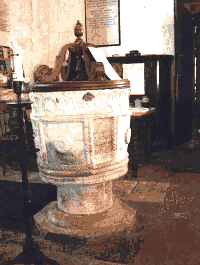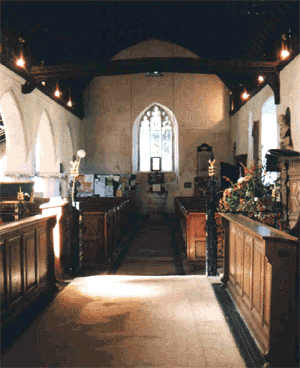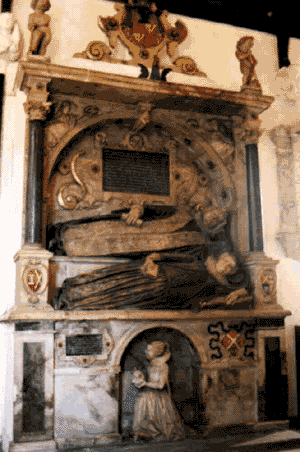The Parish Church of St. Laurence,
Wormley, Hertfordshire, England
 |
Origin
of the Church and Parish
A charter granted by Edward the Confessor dated 1062 endowed the Abbey of Waltham Holy
Cross with the manor of Wormley "with all appurtenances thereto". It is safe to
assume that the appurtenances included a church. This was probably of wooden construction,
but during the first half of the 12th century, a Norman Church was built of which a few
features survive. The first documentary evidence of the existence of a church is to be
found in a charter of 1155 where mention is made of "the church of Wormley", and
in 1161 Pope Alexander III freed "the churches of Epping and Wormley" from all
jurisdiction except that of the Vatican.
|
Situation
Nesting among the trees on the hill half a mile west from the High Road (A1170), the
Church owes much to its quiet surroundings and pleasant situation "far from the
madding crowd" which lend so much to its air of tranquillity. Why is it so far from
the main centre of population in the parish? In answer to this question, it must be
remembered that it was not the A1170 which was important in olden days but Ermine Street,
the Roman roadway from London to the North of England, which passed through the western
divisions of the parish, and was later to form the boundary between the Saxon kingdom of
Mercia and the kingdom of the East Saxons. Holy Cross Hill is part of Ermine Street, and
at its junction with the road leading to Wormley West End, a stone cross was erected in
the 9th century and perhaps earlier. Near this cross stood the Chapel of St. Laurence, so
in Saxon and early Norman times there were two buildings in Wormley, probably both of
wooden construction, bearing witness to the Christian faith.
Features
Some features of the Norman Church built in stone during the 12th century still
survive. The north wall is Norman and retains its original doorway and one small window
adjoining it. The shafts and scalloped capitals of the doorway are restorations. A small
window in the south wall is of Norman pattern suggesting that this was one of the features
of the original south wall.
 |
The Font is an excellent example of Norman work, and the purely decorative treatment
and the absence of Christian symbols and subject matter is not unusual for this period.
The oak cover is a fine example of modern craftsmanship.
|
| |
|
 |
The Nave. The
Church consisted of a single nave and small chancel. It was enlarged in
1862, the south aisle, built of flints, being erected in memory of H. J.
Grant of Wormleybury.
One of the beams of the nave is prominent and dates back to the time of
William Woodlief who purchased the manor in 1541, at the period of the
dissolution of the monasteries. The nave beams - only one survives - are
said to have been erected in celebration of the birth of his grandsons.
At the north-east angle of the
nave, the stairs to the rood loft are still to be seen. These are of 14th or
early 15th century construction. The rood loft itself must have disappeared long
before the construction of the present Chancel arch
|
The pulpit is Jacobean. A drawing
of the interior of the Church by John Buckler in 1830 shows the pulpit on the
south side, with a large back and sound-board and an hour glass. The hour glass
was to ensure that the preacher expounded to his congregation for the full
period as laid down in the rubic. These features did not survive, and after the
chancel had been rebuilt in 1843, the pulpit was moved to the north side.
The Chancel. The chancel arch and windows are all Victorian and belong to the middle of
the 19th century when this part of the church was extensively restored. The wrought iron
screen is also of this period, and is a good example of craftsmanship.
 |
On the south side of the chancel is the Purvey tomb. William Purvey was steward to Sir
Robert Cecil, auditor of the Duchy of Lancaster, and joint lord of the manor. His wife
Dorothy was grand-daughter of Sir Anthony Denny, a favourite of King Henry VIII, and one
of the counsellors of State of Edward VI. William Purvey died in 1617 at the age of 59,
leaving £100 for the erection of this memorial in alabaster. The work is supposed to have
been executed by William Cure the younger, master mason to both James I and Charles I.
|
| |
|
Also on this side of the chancel is a tablet to Richard Gough, the well-known
antiquary, whose historical notes are now preserved in the Bodleian Library.
On the north side of the sanctuary is a tablet to the memory of Angellette Tooke,
daughter of William Woodlief. The date of her death is May 31st, 1598.
There are some interesting
brasses on the floor of the sanctuary. On the north side can
be seen the figures of Edmund Howton and Ann his wife, and five sons. There are probably
some daughters missing. There is a part of a marginal inscription showing the date 1479.
Adjoining this is a gravestone with a brass fragment in Latin, which reads - "Here
lies John Cleve, once Rector of the Church of Wormele who died 22nd October A.D.1404,
whose soul may God accept".
On the south side is a fine brass of Angellette Tooke and Walter Tooke, her husband,
their 8 sons and 4 daughters. The stone and brasses originally formed the top of an altar
tomb. Angellette Tooke's memorial tablet is on the north wall. She was the daughter of
William Woodlief and aunt of William Purvey. On the south side may also be seen the brass
to John Cok, his wife (with her medieval head-dress) and ten sons and daughters. Between
the two figures is a strip of brass with trees and a dog pursuing a hare. Above is a small
representation of the Trinity. The incomplete marginal inscription is as follows-
"Here lyeth John Cok, Yeoman, and Al... passed God out of this
transsitorie...".The date is about 1470.
Two other brasses of Richard Rufton and Edward Sharnbroke, both Rectors of this Church,
were lost, probably during the rebuilding of the chancel.
The beautiful Altar piece depicting the Last Supper, was presented to the Church in
1797 by Sir Abraham Hume (whose bust is to be seen on the north wall of the nave). It is
attributed to Palma Vecchio or, to give him his full title, Jacobo Palma called Il
Vecchio, a Venetian and acording to tradition he was a pupil of Giovanni Bellini, his work
was heavily influenced by Giorgione, Lotto and Titian. The painting was completed in the
middle 16th century. Hume, an art expert and collector of world-wide repute, bought it in
Milan, but it originally belonged to the Rochlin Canons who occupied a monastery near
Verona which had been suppressed. An interesting feature is the dog feeding from a dish
underneath the table. There is a tapestery in St George's Chapel, Windsor showing a
similar feature and it is reputed to have been designed from a picture by Titian.
The furnishings of the chancel include the Organ which was installed in 1883. The
priest's stall was given to the church in memory of Miss Caldecott who died in 1945.
The Tower. The wooden bellcote tower was erected in 1963 in memory of Col.G.Green of
Wormleybury. It follows the design of an earlier one, which according to an old drawing of
the Church, was surmounted by a weather vane bearing the date 1706. The weather vane above
the present tower therefore bears the dates 1706 and 1963. When the old tower was pulled
down it was replaced in 1826 by a stone gable, containing two bells. This was the gift of
Sir Abraham Hume. The stone gable lasted until the erection of the present tower, which
contains the same two bells. It is on record that in 1552 and 1700, the Church possessed
three bells. Whatever happened to the third bell is a mystery which has never been solved.
The Vestry was added to the Church in 1910.
The Lych Gate was built to the memory of the Rev.F.W.Greenstreet, Rector from 1887 to
1906, and was strengthened in 1994.
Parish Records
The Parish registers are now held in the Hertfordshire County Records Office, County
Hall, Hertford. The records start with baptisms in 1674, burials in 1676 and marriages in
1685. The records should have commenced in 1538 but a memorandum written by John Hicks in
1746 notes that "The Regestour Book of Births and Buryals and the old parish
Book" was carried away by the Reverend William Chadwick who was rector from 1690 to
1746.
In 1825 an iron chest was obtained, so that all title-deeds and registers could be
securely kept, which was to be left with Sir Abraham Hume in Wormleybury. The instructions
to secure parish records were not always observed and instructions had to be repeated in
1829, 1831 and 1842.
The Hertfordshire Family and Population History Society have recorded all the legible
Monumental inscriptions in the Church and Churchyard.



